Key takeaways
- Playlists are curated musical journeys that evoke emotions and reflect personal stories, enhancing the listening experience.
- Spotify features, such as collaborative playlists and personalized recommendations, facilitate effortless music curation and discovery.
- Creating effective playlists involves defining a clear theme, thoughtfully selecting tracks, and ensuring a natural flow of energy throughout the collection.
- Sharing playlists fosters connection and community, transforming music curation into a collaborative, enriching experience.
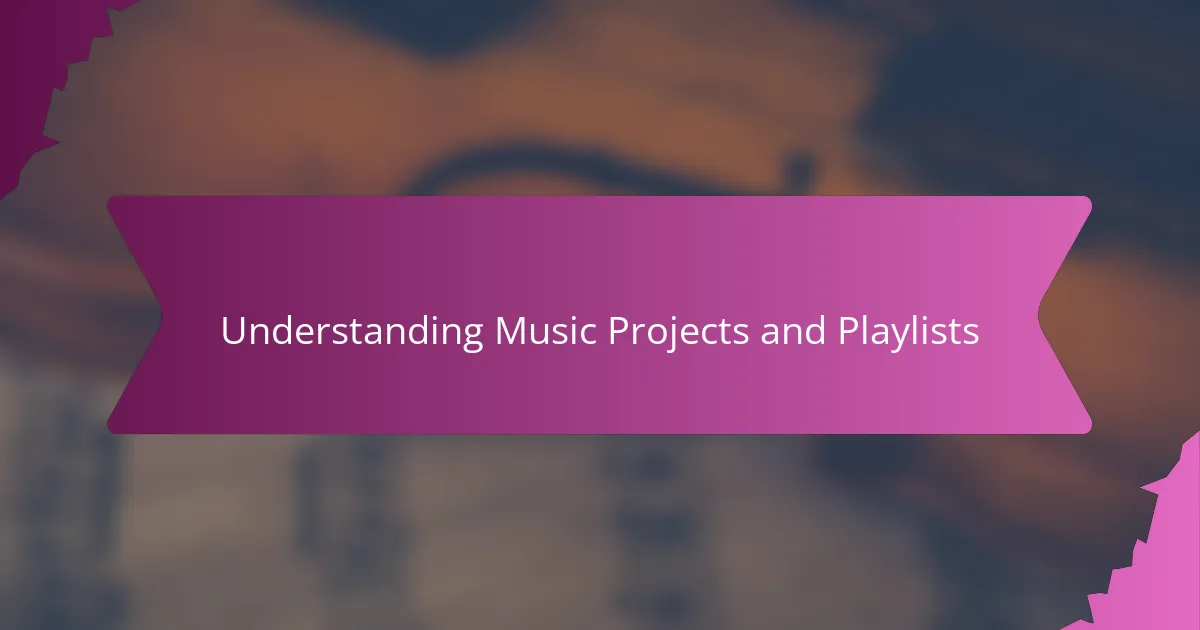
Understanding Music Projects and Playlists
When I first started exploring music projects, I quickly realized that playlists are much more than just collections of songs. They are curated journeys that reflect moods, themes, or even personal stories. Have you ever felt the power of a playlist shaping your day or taking you back to a special moment? That’s the magic behind crafting them thoughtfully.
Music projects often involve a deeper creative process, blending various elements like genres, rhythms, and lyrical themes to tell a story or evoke emotion. I find that understanding this makes my playlists feel less random and more purposeful. It’s like painting with sounds rather than colors, where every track adds a brushstroke to the bigger picture.
What really fascinates me is how playlists can serve different roles — from energizing a workout to providing a soundtrack for reflection. This flexibility is what makes music projects so appealing; they’re living, evolving expressions of our musical tastes and experiences. Don’t you think that gives playlist creation a unique personal touch that standard albums might lack?
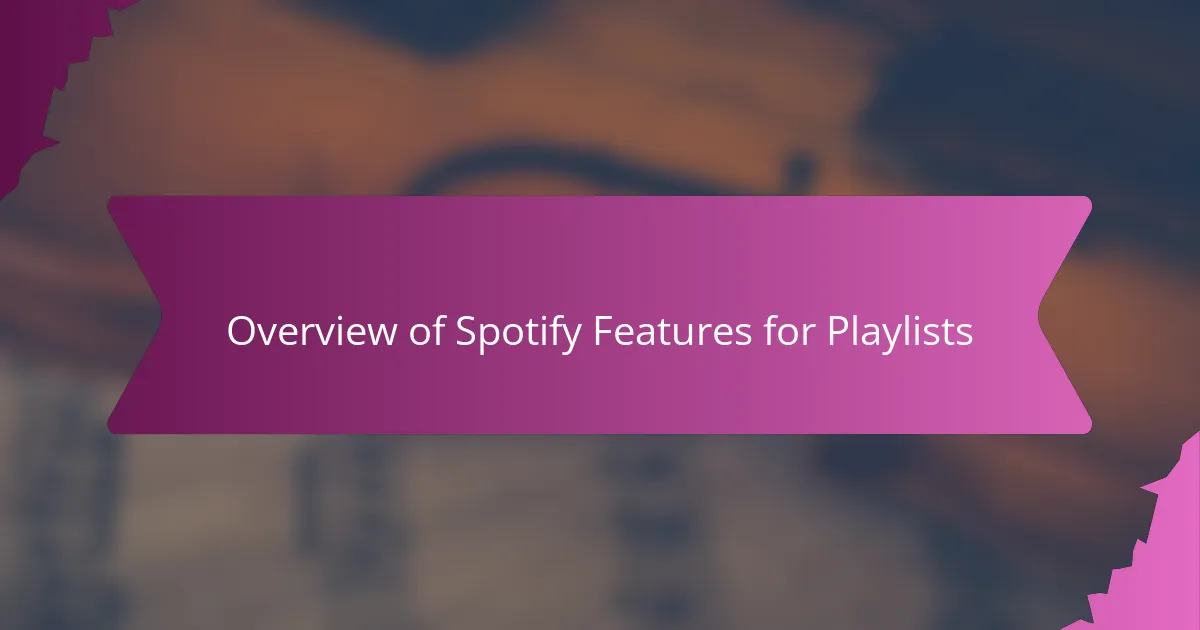
Overview of Spotify Features for Playlists
Spotify’s playlist features have really transformed how I approach curating music. The ability to easily search for songs, add them with a single tap, and reorder tracks on the fly makes the whole process feel intuitive and almost effortless. Have you noticed how seamlessly it blends discovery with organization? That balance keeps me engaged every time I create.
One feature I especially appreciate is collaborative playlists. Inviting friends to add their favorite songs turns playlist-making into a shared experience, which adds unexpected layers to the project. It’s like co-writing a story through music, where each contributor brings a fresh chapter, and that communal vibe can spark creativity in ways I didn’t anticipate.
Then there’s the personalized recommendations Spotify offers right within the playlist interface. When I find new songs that vibe well with my theme, it feels like having a knowledgeable music buddy guiding me. What’s more exciting than stumbling upon hidden gems that perfectly fit the mood you’re trying to capture? These tools make playlist creation an inspiring and ongoing journey for me.
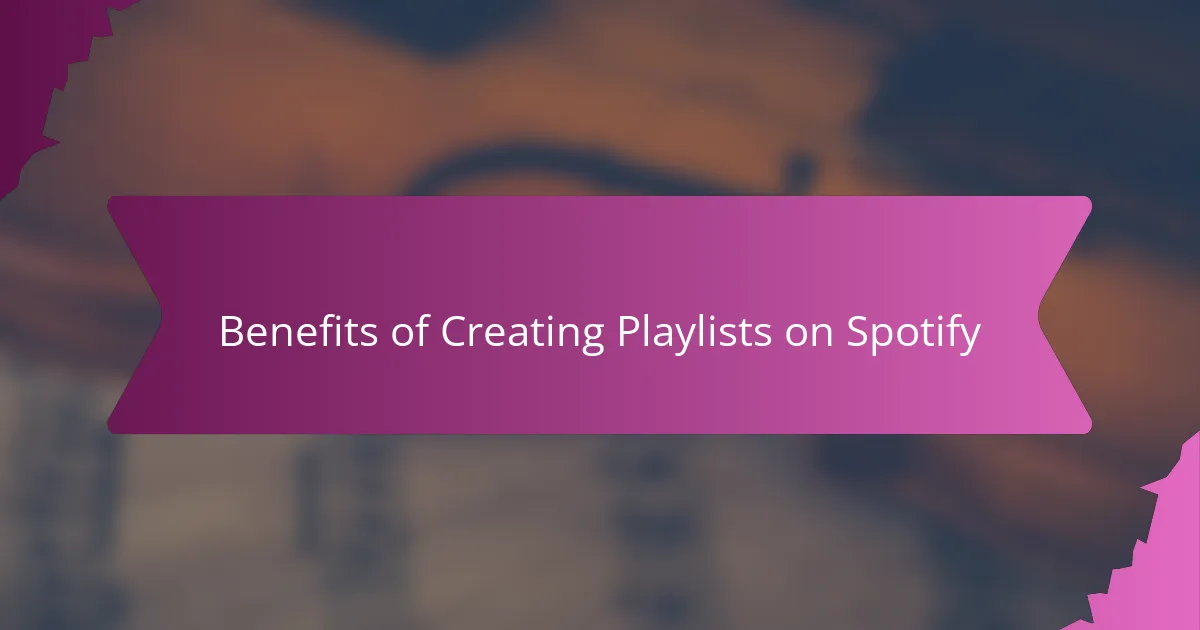
Benefits of Creating Playlists on Spotify
One of the biggest benefits I’ve found in creating playlists on Spotify is how it helps me organize my musical world. Instead of feeling overwhelmed by millions of tracks, I can channel my mood or theme into a neat collection. Have you ever noticed how having your favorite songs all in one place can instantly boost your day or calm your nerves? That sense of control over my soundtrack makes the whole experience deeply rewarding.
Spotify also makes sharing these playlists incredibly simple, which, to me, adds a whole new layer of joy. Whether I’m introducing friends to new artists or collaborating on a shared mix, it’s like building a community one song at a time. I remember once sharing a workout playlist with a friend, and it became our unofficial motivation ritual. Isn’t it amazing how music can connect us in such personal ways?
Another thing I love is how Spotify’s features inspire discovery right within the playlist creation process. When suggestions pop up that fit perfectly, it feels like a little gift from the algorithm. It’s thrilling to uncover tracks I wouldn’t have found otherwise, enriching my playlists with fresh sounds. Have you ever felt that spark when a new song catches you off guard and suddenly becomes your new favorite? That’s the kind of surprise that keeps me coming back.
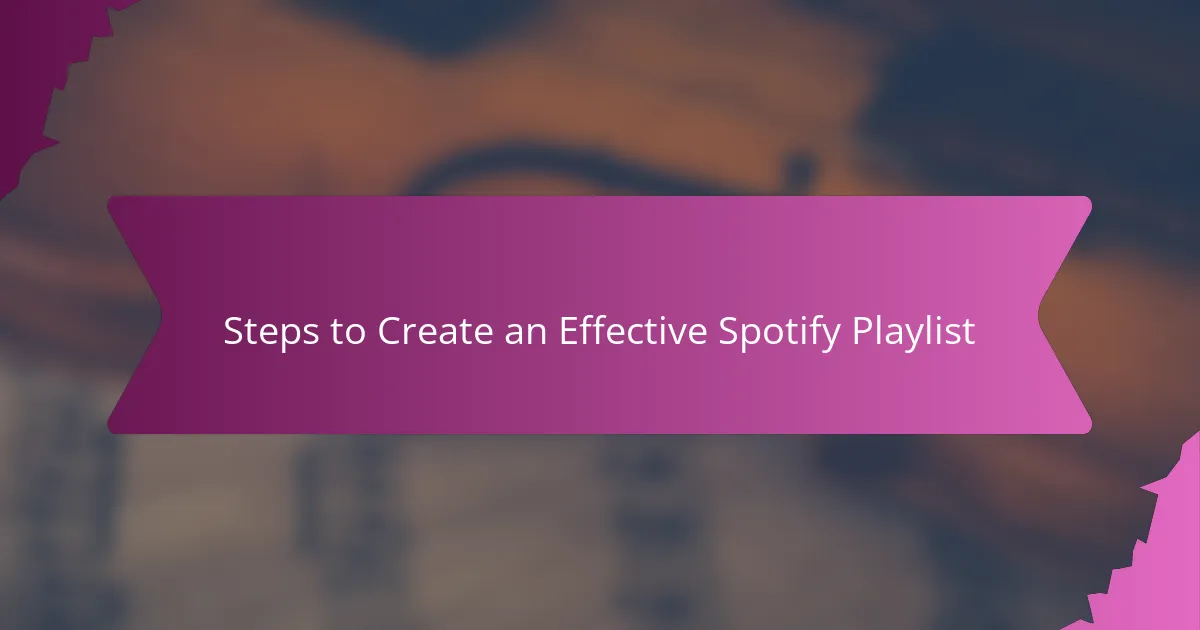
Steps to Create an Effective Spotify Playlist
The first step I take when creating a Spotify playlist is to decide on a clear theme or mood. Without that focus, the collection of songs can feel scattered, like a jumbled mixtape instead of a flowing experience. Have you ever started adding random tracks only to realize the playlist needed a stronger story? Defining the vibe upfront keeps me on track and helps every song feel intentional.
Next, I dive into Spotify’s vast library to handpick each track, paying attention not just to favorites but also to hidden gems that complement the mood. Sometimes I spend more time exploring new music than actually building the list, which turns the process into a rewarding little adventure. What’s fun is how occasionally a recommended song surprises me and perfectly fits the vibe I’m crafting — like the playlist itself is guiding me.
Finally, I always test the playlist from start to finish, tweaking the order so the energy rises and falls just right. It’s like pacing a story, making sure there’s a reason behind every transition. I find this step crucial because it turns a simple list of songs into a journey listeners can feel. Don’t you think a well-structured playlist can make all the difference in how we connect with music?
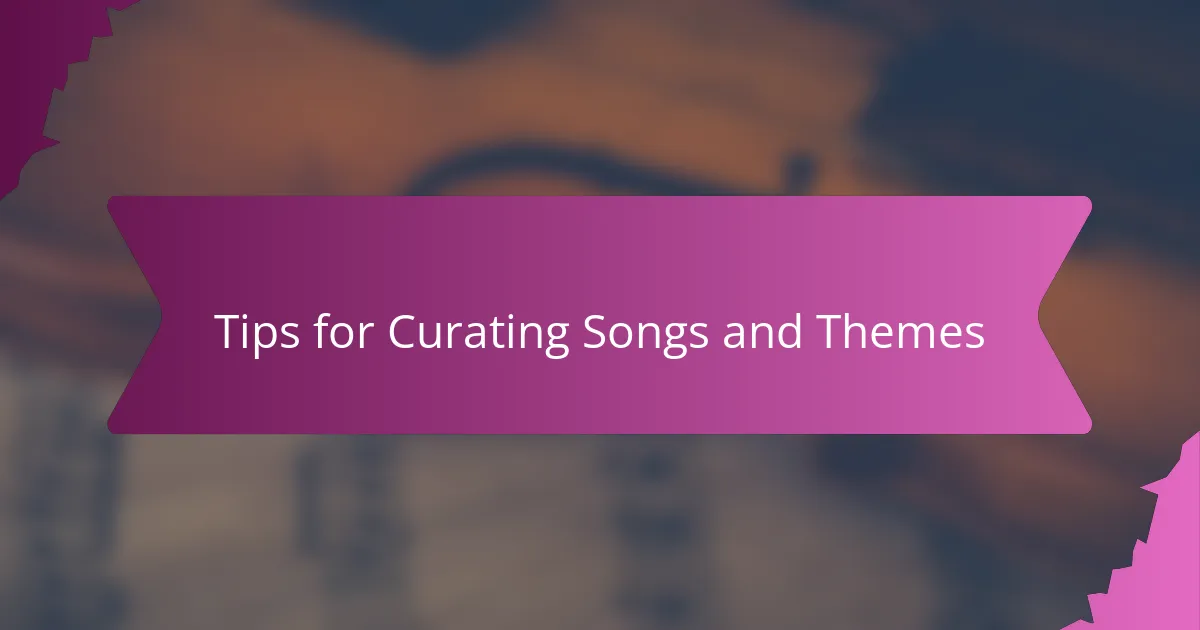
Tips for Curating Songs and Themes
When curating songs and themes, I find it essential to lean into a specific mood or story that resonates emotionally. Have you ever noticed how a single well-chosen track can anchor the entire playlist’s vibe? It’s like setting the tone for a conversation that unfolds with every added song.
I also like to mix familiar favorites with unexpected discoveries. This balance keeps the playlist engaging and fresh, preventing it from becoming too predictable. For instance, once I slipped in an obscure indie track between mainstream hits, and it completely transformed the mood—spiking curiosity and delight at the same time.
Another tip I swear by is grouping songs thoughtfully by energy or lyrical content. When songs flow naturally from one to the next, it’s easier to stay immersed. Don’t you think that kind of smooth progression makes the difference between a playlist that feels like background noise and one that tells a real story?
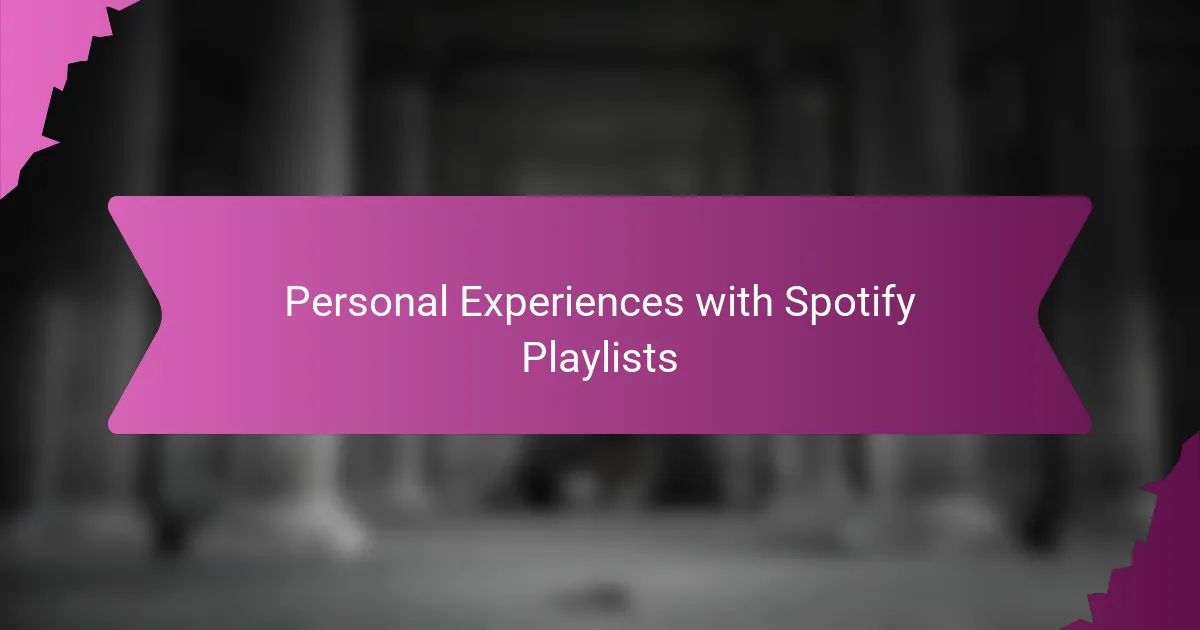
Personal Experiences with Spotify Playlists
Creating playlists on Spotify has become a personal ritual for me. I remember one evening when I was feeling nostalgic; putting together songs from my teenage years not only revived memories but also gave me a comforting sense of connection to my past. Have you ever experienced how a playlist can serve as a time machine, bringing back emotions you thought were long gone?
Sometimes, I treat playlist creation as a way to explore new sides of myself. For example, while assembling a mix for a relaxing weekend, I let Spotify’s recommendations nudge me toward genres I wouldn’t normally choose. It’s exciting how this process can broaden my musical horizons and introduce me to artists who soon become favorites. What about you—do you let discovery play a role in your playlist journey?
There was also this memorable moment when I shared a playlist with friends before a road trip. Each of us contributed songs, and the collaborative creation made the journey feel even more special. It struck me how a simple collection of tracks could strengthen bonds and create new shared memories. Isn’t it amazing how music brings people together, even through something as simple as a playlist?
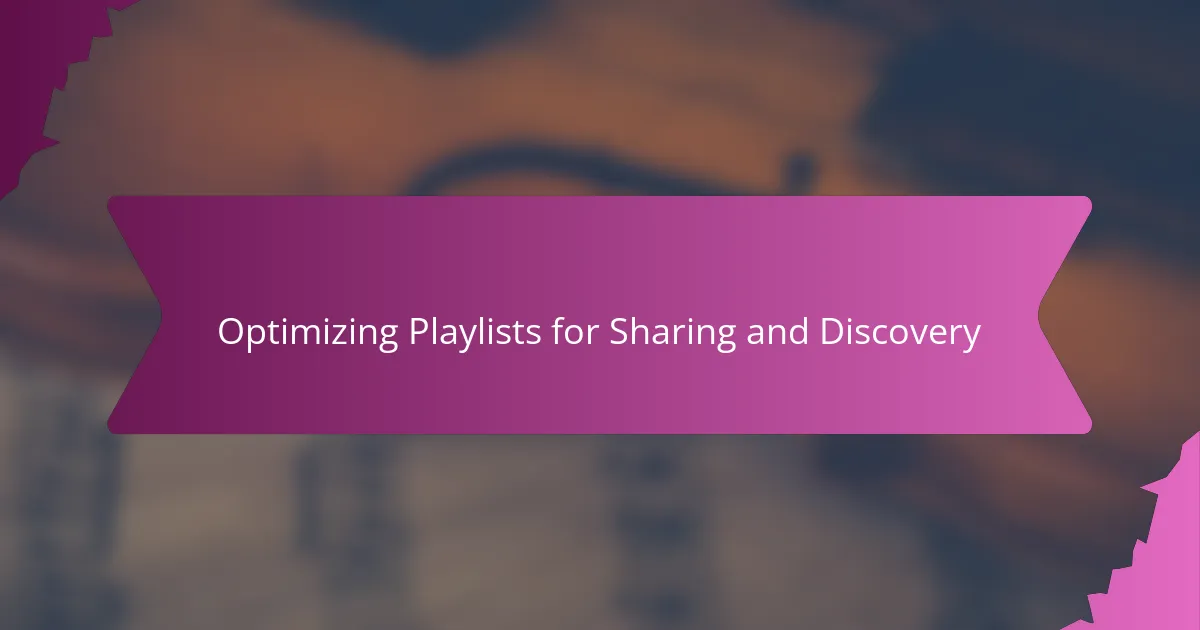
Optimizing Playlists for Sharing and Discovery
When I think about optimizing playlists for sharing and discovery, the first thing that comes to mind is the importance of a clear, inviting title and description. Have you ever clicked on a playlist just because its name piqued your curiosity? That’s exactly why I spend time crafting descriptions that hint at the vibe or story behind the mix—it feels like an open invitation to explore without spoiling the journey.
I’ve noticed that organizing songs in a way that flows naturally not only improves the listening experience but also encourages more shares. When friends tell me a playlist felt like a seamless soundtrack rather than a random shuffle, I know I’ve hit the right balance. It’s a bit like telling a story where each chapter leads fluidly into the next, which makes others want to hit replay and share it with their circle.
Another trick I often use is tapping into Spotify’s social features, like collaborative playlists or sharing directly to social media. These tools have turned playlist sharing into a two-way conversation, often leading to unexpected song suggestions or fresh insights that breathe new life into my collections. Don’t you find that a playlist shared with friends suddenly feels more personal and alive? For me, that’s where the true magic of discovery begins.